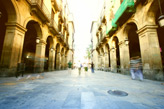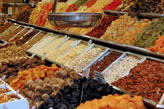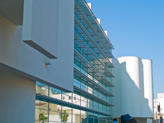The Old Town

As mentioned, Cuitat Vella (The Old Town) comprises four main areas: El Raval, Barri Gotic, El Born, and La Barceloneta. The latter is an old fishing village which was built on the natural banks of the Mediterranean, and has its own distinct style, festivals and, for the sun-seeker, the city's closest beach. The area houses small apartment blocks in tiny streets which run parallel to each other starting from the beach front and stretching back to the harbour with moored yachts and boats, as well as some of the city's finest restaurants. The majority of apartments here are small – 1 or 2 bedroomed, and very few have elevators.
The border of Barceloneta then joins El Born – really an extension of the Barri gotic or the Gothic Quarter. This is a mainly pedestrian area, with small windy streets and has many beautiful buildings from Roman times, as well as some of the cities oldest churches. Town planning recently discovered Roman remains whilst refurbishing the Market of Santa Maria del Mar, which have been cleaned and preserved and can be viewed by the public. Following on from El Born is the Barri Gotic; again, a mainly pedestrian area and the Medieval part of the city, with a plethora of shops, boutiques, and small restaurants. This area is also famous for housing some of the city's main attractions, such as the Cathedral of Barcelona dating from the 13th century, and a perfect example of Gothic architecture, the Picasso Museum, the Textile Museum – even the Chocolate Museum! Also in the middle of this area is the Plaça Sant Jaume, which houses the City Hall and the Catalan government headquarters. The Barri Gotic has its border on one side with the Cuitadella Parc – named “Barcelona's Garden” – which houses the city's zoo, fountains, a former citadel, lakes with boat rides, and children's play areas.

The other side of the Barri Gotic, starting from the port, is the world famous Las Ramblas – a 1km stretch of everything that is Barcelona. The towering monument of Christopher Colombus stands at the bottom of Las Ramblas, pointing the way to the new Americas, and the starting point of a cultural journey you'll never forget! The monument also has a viewing gallery at the top, with a lift to take you up and enjoy the view. Moving north, you'll find the city's Wax Museum on the right, tucked away down a little alleyway – although the museum itself is fairly large. On the opposite side is the Santa Monica Art Centre. Fitting, then, that this is also full of 24 hour stalls of the city's painters, artists, charicature & portrait painters, amongst many things. Continue walking and you'll find one of the many, many street performers – maybe a human statue, maybe a juggler, maybe even Bart Simpson. Also here begin the many pavement cafés and bars – some of the most famous and oldest in the city, where it's almost impossible not to stop and have a coffee, a beer or a jug of sangria while you watch the world go by.
Las Ramblas is littered with 24 hour newspaper kiosks selling national and international press, magazines and books. Don't ask them for stamps, though – you have to go to the tobacconists (Tabac) for those. Halfway up Las Ramblas on the left, you'll find the Plaça Reial (Royal Square), with pavement cafés and bars, restaurants, clubs and discos, and a fountain in the middle. On the opposite side of Las Ramblas is the Liceu Opera House and La Boqueria market – the most famous food market in the city, with absolutely everything you can eat on offer – if you can't find it in La Boqueria, it doesn't exist! Continue on your way, passing the Palau de la Virreina – always has an interesting exhibition – on the left and the Erotic Museum on the right until you reach Plaça Catalunya – the city's main square, flanked by two fountains “Les Fonts de Canaletes”. Legend has it that if you drink from the fountains, one day you'll return to Barcelona. Here you'll also find one of the city's main Tourist Information offices and the tourist bus.

From the bottom of Las Ramblas to the left (as you look at the map) is the border of El Raval. This area is surrounded by the old Roman defence wall, most of which can be still seen, along Paral.lel street, and don't miss the beautiful Sant Pau del Camp church - the Romanesque church which survived the civil war. This diverse area of the city was recently recognised as the world's most ethnically diverse urban space. Variety is the spice of life, and this area has many diverse shops, restaurants, art as well as some of the newest bars and clubs, nestled next door to some of the most famous restaurants. This area of the city also hosts the Maritime museum, the new MACBA Modern Art museum, the Palau Güell - one of Gaudi's most famous buildings - and also boasts the city's Sonar Music Festival, held in a handful of places in this neighbourhood each year.
Like the sound of the old town? Why not check out some of our old town apartments?
Old Town 1 | Old Town 2 | Old Town 3 | Old Town 4
Next | Las Ramblas
This page is valid: XHTML 1.0, CSS 2.0 | Secure payment form | Privacy | Contact |
